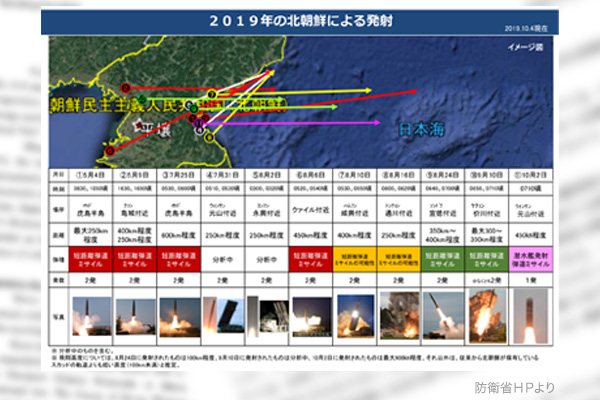On October 2, North Korea test-fired a “Pukguksong-3” submarine-launched ballistic missile from waters off Wonsan on its eastern coast. The SLBM was launched at a lofted orbit and dropped into Japan’s exclusive economic zone. The missile, if launched into a usual orbit, could fly over up to 2,500 kilometers, covering whole Japan, Japanese Defense Minister Taro Kono said.
Some media reports say that a North Korean submarine could target the U.S. mainland if it moves to waters near the U.S. coast. However, it is very difficult as of now for North Korean noisy submarines to pass through Japan-controlled straits without being detected. Short-range missiles that are difficult to intercept with ballistic missile defense systems would be sufficient to target South Korea. Therefore, Japan has to be viewed as a main target for the “Pukguksong-3” missile. “North Korea is assessed as having already successfully miniaturized nuclear weapons to fit ballistic missile warheads,” admitted Japan’s defense white paper for the first time in its 2019 edition released in late September.
Nevertheless, President Donald Trump of the U.S. with which Japan is allied has failed to complain about the latest missile firing test as well as the recent series of short-range ballistic missile tests that violated United Nations Security Council resolutions, going ahead with Washington’s working-level meeting with Pyongyang. An implied message from President Trump may be that Japan should defend itself on its own.
Dramatic changes in the Northeast Asia situation have called into question the advisability of Japan’s basic defense policies such as the exclusively defense-oriented policy and the three non-nuclear principles.
How to lead China to join missile reduction negotiations
On October 1, China carried out its largest military parade in history to mark the 70th anniversary of the People’s Republic, featuring notably various ballistic missiles including hypersonic types that are difficult to intercept with current missile defense systems.
Left unbound by the Intermediate-Range Nuclear Forces Treaty signed by the U.S. and the former Soviet Union in 1987, China has developed and deployed intermediate-range ground-launched missiles subject to a ban under the INF treaty. Concerned about the Chinese move, the U.S. withdrew from the treaty earlier this year. In August, U.S. Defense Secretary Mark Esper indicated a hope to deploy intermediate-range ground-launched missiles in Asia.
It is reasonable for the U.S. to deploy such missiles in Asia to counter Chinese missiles and lead China to join negotiations on the reduction of INF missiles. Given that Australia and Guam are too far from China and that it is politically difficult for the U.S. to deploy such missiles in South Korea, Taiwan or the Philippines, U.S. INF deployment sites may be limited to Japan. If the U.S. is to deploy such nuclear missiles in Japan, Tokyo would have to modify the three non-nuclear principles of not possessing, producing or bringing in nuclear weapons.
Japan’s pacifist Article 9 seen as an obstacle
It is difficult for any existing missile defense system to intercept short-range ballistic missiles fired by North Korea since late May and the DF-17 hypersonic gliding missile displayed by China in its military parade on October 1. These missiles may be shot down with laser attacks from unmanned aerial vehicle (UAV) during their boost phase or destroyed at their sites before launching. Given the present laser power capacity, laser attacks may fail to destroy missiles unless they are made from UAV very close to the targets. Attacks on missile launching sites in foreign countries would be difficult for Japan under its exclusively defense-oriented policy.
The pacifist Article 9 of the Japanese Constitution might have become an obstacle even for President Trump urging foreign countries to defend themselves on their own.
Fumio Ota is a senior fellow and a Planning Committee member at the Japan Institute for National Fundamentals. He is a retired Vice Admiral of Japan’s Maritime Self-Defense Force.


